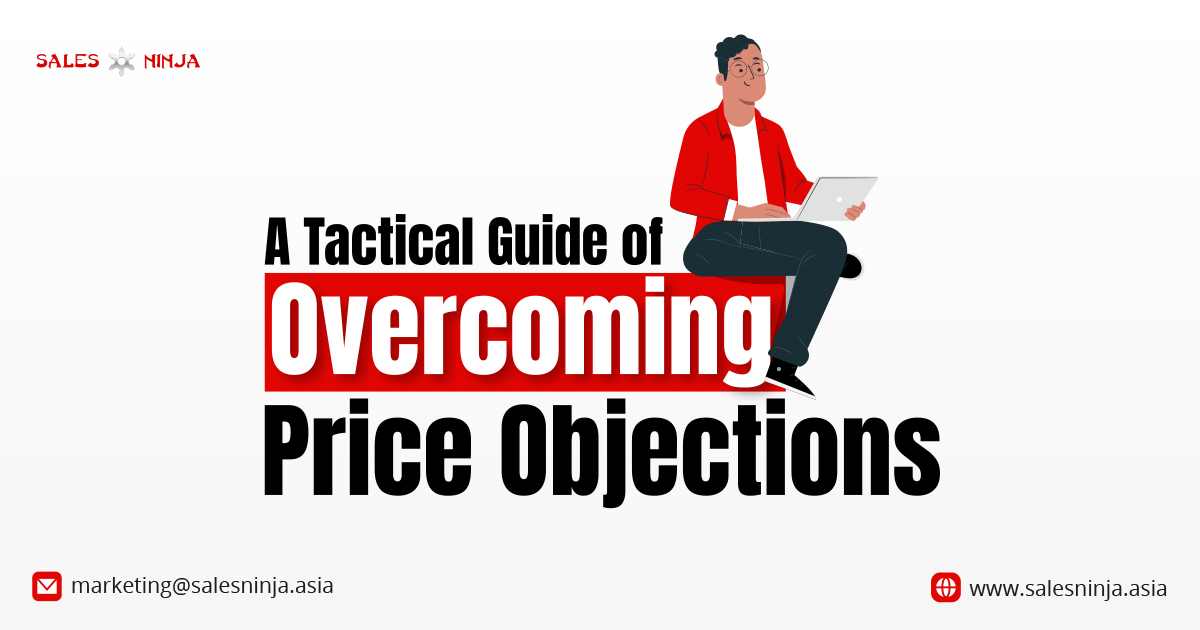Price objections are among the most significant challenges a salesperson faces, often having a substantial impact on the success or failure of a deal. These objections usually arise from concerns about the value for money and trust in the investment, touching upon several of the five basic obstacles in sales identified by Zig Ziglar, a renowned sales strategist: no need, no money, no hurry, no desire, no trust.
“Every sale has five basic obstacles: no need, no money, no hurry, no desire, no trust.”- Zig Ziglar
Understanding these objections goes beyond mere numbers and budgets. It’s about deeply understanding the customer’s mindset, ensuring that the value of the product or service aligns with their needs, and communicating this alignment effectively and convincingly. This aspect becomes particularly crucial in B2B sales, where the stakes and the prices are typically higher. In these scenarios, decision-making is driven more by logic and return on investment (ROI) than by emotion, making the management of price objections a critical skill for sales professionals.
Therefore, here, we’ll delve into the complexities of overcoming price objections in B2B sales.
What is a Price Objection?
A price objection is essentially when a potential customer, or lead, pushes back on the cost of your offering. It’s that moment in a conversation when they feel the price doesn’t align with their perceived value of the product or service you’re selling.
But why do these objections arise so frequently?
These objections usually happen because people don’t see how the price matches the value. If companies think they’ll get good returns or benefits from what they’re buying, they’re happy to pay. But if they’re not sure about what they’ll gain or how it will help, they might hesitate or think it’s too expensive, and sadly, as salespeople, we often fail to effectively communicate the value proposition to potential customers.
Types of Price Objections
When it comes to overcoming price objections in B2B sales, they typically fall into several key categories:
Budget Constraints:
Here, the buyer feels the cost is beyond what they can afford or is more than the budget set aside for this kind of purchase. Here are some examples:
- “This exceeds our allocated budget for such projects.”
- “We’d love to go ahead, but we just don’t have the funds right now.”
- “Our budget has been slashed due to recent cutbacks.”
- “We can’t justify this expense to our stakeholders.”
- “It’s a great product, but it’s simply out of our price range.”
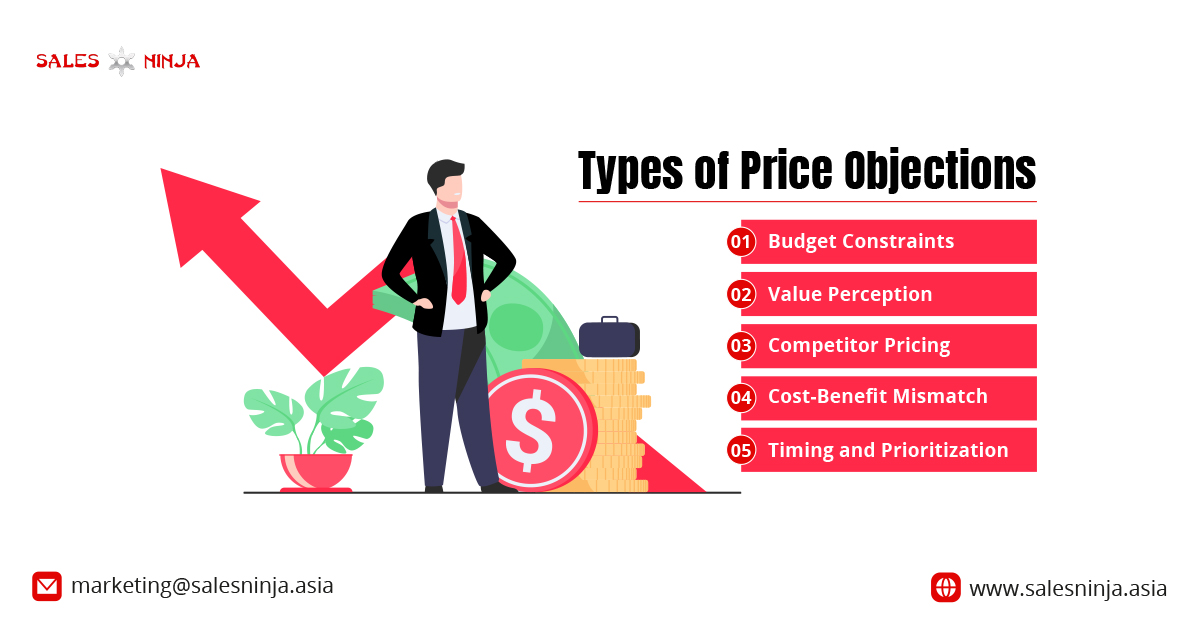
Value Perception:
This type involves doubts about the product’s worth. Buyers may not be convinced that the product or service justifies the cost. For instance:
- “I’m not sure we’ll see a return on this investment.”
- “How can we be sure that your product is better than a cheaper alternative?”
- “This price doesn’t seem to match the benefits you’re listing.”
- “I don’t see how this is a better value than what we currently use.”
- “The cost seems high for what we’re getting in return.”
Competitor Pricing:
Buyers might object if they know of similar offerings available at a lower price from competitors. Examples include:
- “Your competitor is offering a similar product at a lower price.”
- “We’ve received a more competitive quote from another company.”
- “Why should we choose you when there are cheaper options available?”
- “X company is giving us more features for a lesser price.”
- “We can only consider your service if you match what the competition is offering.”
Cost-Benefit Mismatch:
In this category, the objection arises from the buyer’s belief that the cost is not proportional to the benefits or outcomes they expect to receive. Look at these examples:
- “The long-term benefits don’t seem to justify the immediate costs.”
- “For such a high investment, the results don’t seem significantly different.”
- “We’re worried about the cost versus the actual utility we’ll receive.”
- “The product is good, but not enough to invest so much.”
- “We need to see more advantages before agreeing to such an expense.”
Timing and Prioritization:
Sometimes, the objection is not strictly about the price but about timing or current priorities, with the buyer feeling that the investment isn’t urgent or important right now. Examples here:
- “We’re not focusing on this area of our business at the moment.”
- “We have other priorities that require our budget right now.”
- “Maybe next quarter/year when we’ve reevaluated our needs.”
- “We’re currently investing our resources in a different project.”
- “It’s a great offer, but the timing isn’t right for us.”
Understanding these categories and the specific examples helps tailor your response to each objection. Addressing them correctly can turn a potential “no” into a confident “yes”!
A Step-by-Step Guide to Overcoming Price Objections
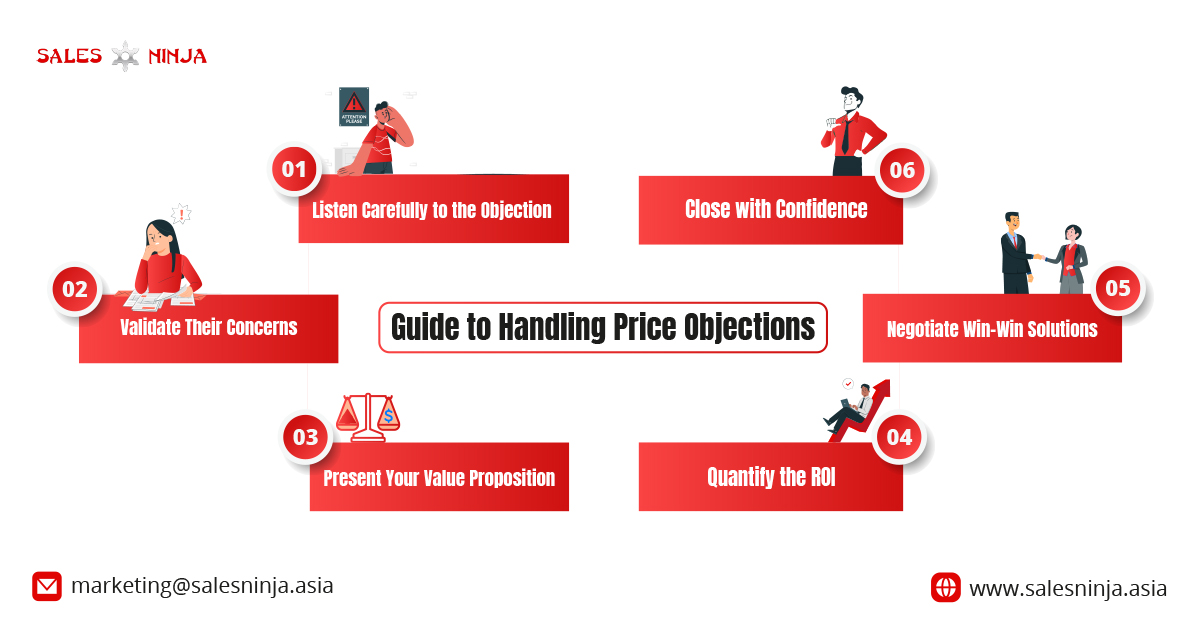
Navigating through overcoming price objections doesn’t have to be a stumbling block in your sales process. Let’s break down a simple, effective way to handle these objections, ensuring you stay on track toward closing your deals.
Step 1: Listen Carefully to the Objection
Hear what the client is saying. Is the concern purely about cost, or is there something deeper, like value or budget constraints? Stay quiet until they’ve finished speaking; don’t interrupt. Let them know you understand why they might feel the price is high.
Step 2: Validate Their Concerns
Acknowledge their feelings and concerns. Validation doesn’t mean you agree, but it shows respect for their viewpoint. Use phrases like “I understand where you’re coming from” to demonstrate empathy. Avoid getting defensive about your pricing.
Step 3: Present Your Value Proposition
Reiterate how your product/service can solve their problems or add value to their business.
Focus on the benefits that are most relevant to their concerns. Use simple examples or stories to illustrate your points.
Step 4: Quantify the ROI
Show in clear terms how the investment in your product/service will pay off for them. Use data and case studies to back up your claims. Paint a picture of the future where your product has made a significant impact on their success.
Step 5: Negotiate Win-Win Solutions
If price is still an issue, work to find a middle ground that benefits both parties. Be creative with your solutions — maybe offer different payment plans or bundled services.
Remember, negotiation is about give and take; be prepared to compromise to some degree.
Step 6: Close with Confidence
Once you’ve addressed their objections and found a mutual agreement, confidently ask for the sale. Summarize the key benefits and value again briefly. Ask directly for their business with a simple question like, “Shall we move forward with this plan?”
Each step in this process plays a vital role in overcoming price objections into successful sales. By listening, validating, and carefully presenting your arguments, you can guide the conversation to a positive outcome. And always remember, confidence and clarity go a long way in sealing the deal!
Strategies for Overcoming Price Objections
Overcoming price objections in B2B sales isn’t just about sticking to your guns; it’s about smart, strategic conversations and tactics. Here’s how you can turn a potential ‘no’ into a ‘yes’:
Value Demonstration
Value Demonstration involves clearly illustrating the unique benefits and worth of your product or service, ensuring the customer understands what they gain versus what they pay. This approach is crucial in handling price objections, as it shifts the conversation from cost to value.
It counters the price objection by reinforcing the idea that the price is justified — or even a bargain — given the value offered.
Strategies Under Value Demonstration:

- Highlight Unique Features: Point out what sets your product apart from competitors. If your software offers an exclusive feature that boosts efficiency, emphasize it.
- Use Data and Case Studies: Present statistics or success stories showcasing the measurable benefits others have gained.
- Personalize the Benefits: Tailor the value proposition to meet the specific needs or pain points of the customer. If they’re concerned about efficiency, show how your product saves time.
Reframing Around ROI
Reframing around ROI (Return on Investment) means shifting the focus of the pricing discussion from the immediate cost to the long-term returns and benefits the investment will bring.
This reframing helps clients see the larger picture, understanding that initial investment might lead to greater savings or earnings in the future, thus justifying the price.
Strategies Under Reframing Around ROI:
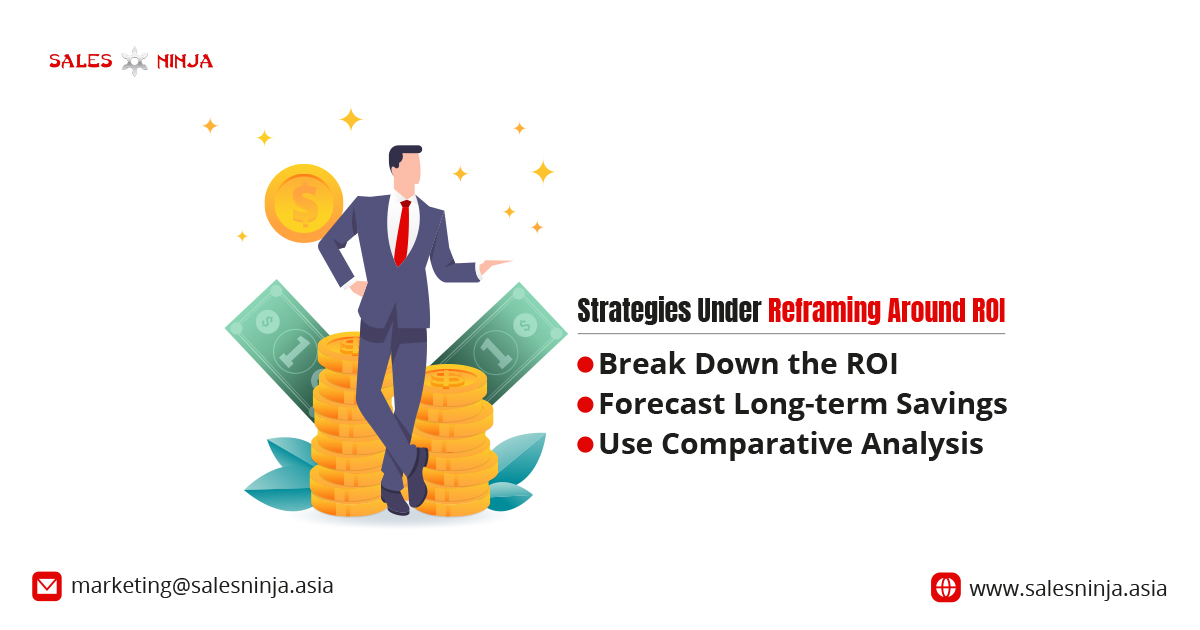
- Break Down the ROI: Provide a clear, quantifiable breakdown of how and when the client can expect returns from their investment.
- Forecast Long-term Savings: Illustrate future cost savings or revenue enhancements that your product/service will deliver.
- Use Comparative Analysis: Show how the cost of not using your product (in terms of lost opportunities or continued expenses) can be greater than the investment in your product.
Negotiation Techniques
Negotiation Techniques in sales involve strategic discussions where both parties look for common ground to reach a mutually beneficial agreement, often involving trade-offs or adjustments.
This strategy is about finding flexible, creative solutions that align with both the client’s budget constraints and your pricing standards.
Strategies Under Negotiation Techniques:
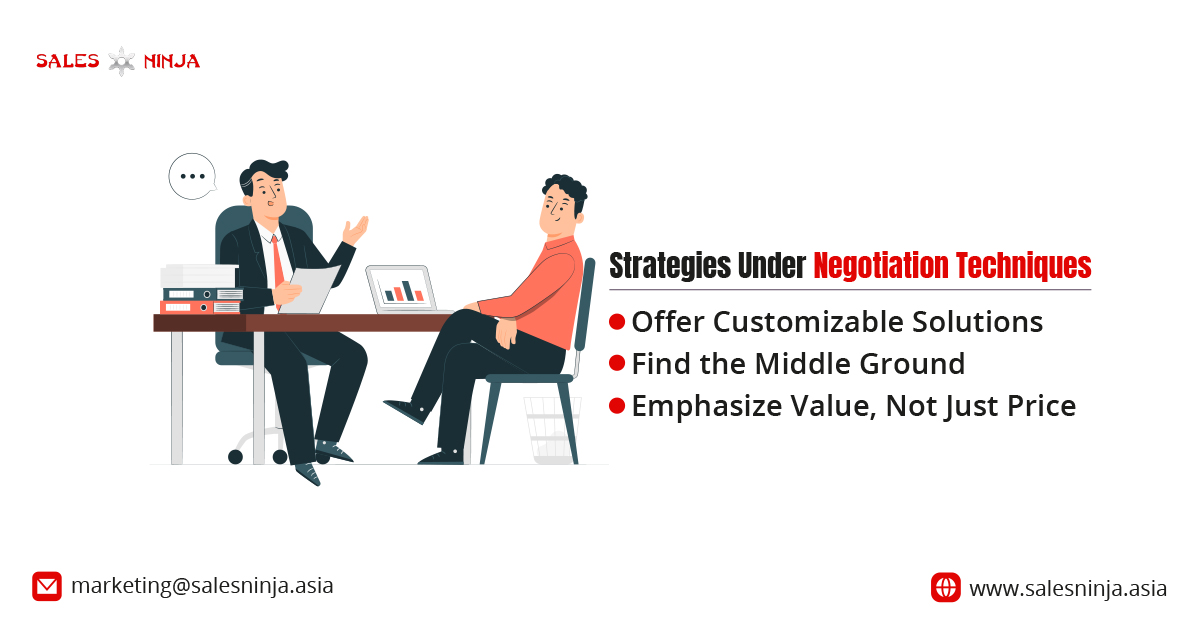
- Offer Customizable Solutions: Instead of a one-size-fits-all, offer various tiers or packages that can suit different budget levels.
- Find the Middle Ground: If the client wants a lower price, propose adjusted service levels or longer-term contracts in return.
- Emphasize Value, Not Just Price: When negotiating, keep bringing the conversation back to the value and benefits, rather than just the price tag.
Each of these strategies serves to transform a price objection from a deal-breaker into an opportunity for deeper dialogue and mutual understanding. The key is to maintain a focus on value, return on investment, and flexible solutions that respect both your product’s worth and the client’s constraints.
Psychological Tactics in Pricing:
Anchoring Effect: Start with a higher initial price as the anchor; subsequent lower offers will seem more reasonable in comparison.
Framing Effect: Position your price against a more expensive option to make it seem more affordable.
Common Price Objections with Example Responses
Let’s explore a few typical price objections that often arise in B2B scenarios and discuss how you can effectively respond to each.
-
“Your prices are higher than Company X….”
They’ve seen cheaper options and wonder why they should pay more.
Response: “Totally hear you on the price difference. It’s important to look at what you’re getting for that price. With us, it’s not just the product, but [highlight unique benefits or services]. How does that sound for your needs?” -
“We just don’t have that kind of budget right now…”
Either their budget is really tight, or they’re still weighing up your value.
Response: “Budgets can be tight; I get that. What if we looked at how our service could actually save or make you more money down the line? Maybe we could work something out that fits your budget?” -
“I need to think about it; it’s a big investment…”
They’re interested but hesitant. They need reassurance about the value.
Response: “Absolutely, it’s a significant decision. Let’s walk through how this investment can bring you returns. We’re all about making sure it’s worth every penny for you.” -
“I’m not seeing the value for the cost here…”
They’re not convinced about what they get for the price.
Response: “I appreciate your honesty. Can I show you some of our success stories or a breakdown of how our pricing translates into real-world benefits for your team?” -
“Can you give us a discount?”
They’re interested but trying to see if there’s wiggle room on price.
Response: “I can’t promise anything upfront, but let’s dive into what you’re looking for and see if there’s a way to make things work on both ends. How does that sound?” -
“We’re considering several options, and price will be a big factor…”
Price is crucial in their decision, and they’re shopping around.
Response: “That’s fair. While we’re talking about numbers, let me share why our customers find the extra investment worthwhile and how it pays off in the long run.” -
“This will blow our budget for the year…”
The price is significantly higher than what they planned to spend.
Response: “It sounds like we need to find a solution that doesn’t hurt your annual budget. Have you thought about a phased approach where the costs are spread out more?” -
“Your competitor is offering the same service for less…”
They’ve got a cheaper alternative and want to know why they should choose you.
Response: “Competition keeps us on our toes! Let’s compare what both of us offer. I think you might find some aspects where we have the edge, which could be a game-changer for you.” -
“I’m not sure the higher cost translates to higher quality…”
They doubt that spending more means getting more.
Response: “I wouldn’t want you to spend more without good reason. Let’s look at some concrete examples of what extra quality and service you get with us. It might help clarify things.” -
“This looks great, but we need to cut costs this quarter…”
They like your product but are under immediate financial constraints.
Response: “Cutting costs is key, especially now. Let’s figure out a plan that gives you what you need without putting pressure on this quarter’s budget. Maybe we can spread the investment over a longer period?”
These responses aim to blend empathy with a touch of salesmanship, keeping the conversation grounded, relatable, and solution-oriented. Does this style feel more aligned with your vision?
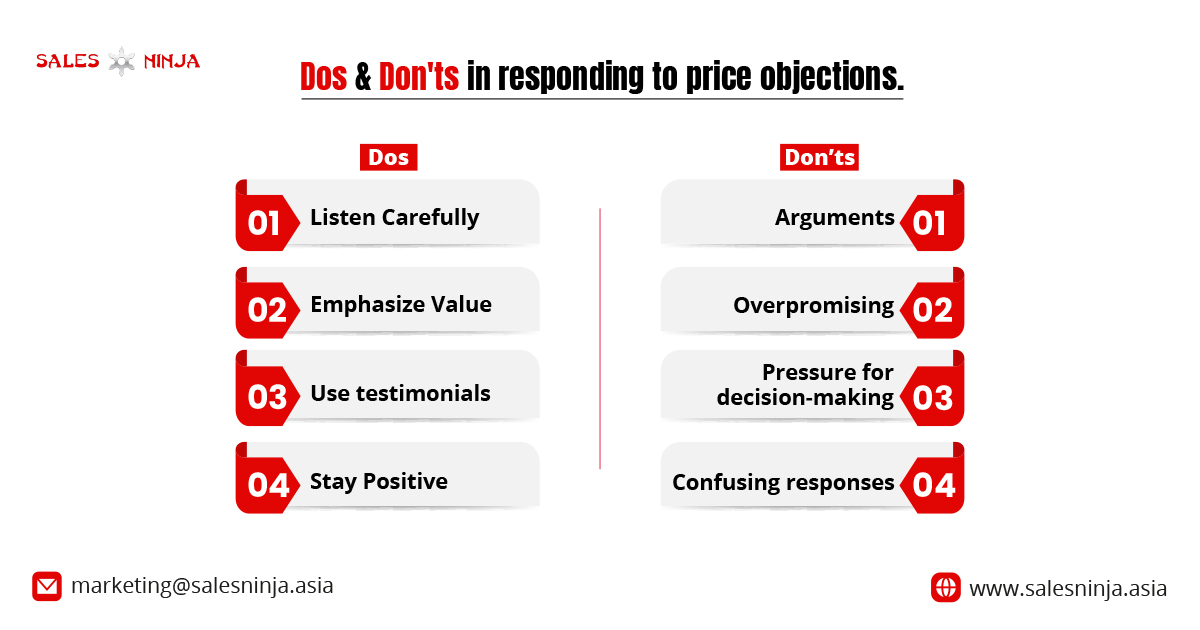
In B2B Sales, overcoming price objections is about understanding your customer, showing empathy, and clearly communicating the value your product brings. Remember, each objection is a chance to improve your pitch and strengthen your customer relationships.
Show your customers the real-world benefits and ROI they can expect. With patience, strategy, and a bit of finesse, you’ll turn those objections into successful deals. Keep learning, keep adapting, and keep growing in your sales journey.

